| Sadeh
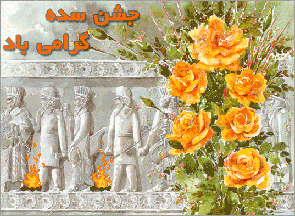 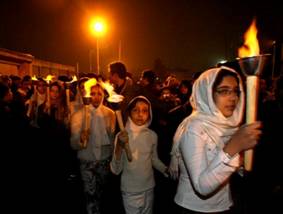
Sadé or Sada Jashn-e Sada/Sadé, also transliterated as Sadeh, is an ancient Iranian tradition celebrated 50 days beforeSadeh. Sadeh in Persian means "hundred" and refers to one hundred days and nights past the end of summer (or the beginning of long-winter known to start at the end of summer in ancient Iran). Sadeh is a mid winter festival that was celebrated with grandeur and magnificence in ancient Iran. It was a festivity to honor fire and to defeat the forces of darkness, frost, and cold.
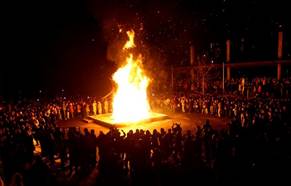 Legends have it that King Hushang, the 2nd king of the mythological Peshdadian dynasty(Peshdad means to give the Law), established the Sadeh tradition. It is said that once Hushang was climbing a mountain when all of a sudden he saw a snake and wanted to hit it with a stone. When he threw the stone, it fell on another stone and since they were both flint stones, fire broke out and the snake escaped. This way he discovered how to light a fire. Hushang cheered up and praised God who revealed to him the secret of lighting a fire. Then he announced: "This is a light from God. So we must admire it." Legends have it that King Hushang, the 2nd king of the mythological Peshdadian dynasty(Peshdad means to give the Law), established the Sadeh tradition. It is said that once Hushang was climbing a mountain when all of a sudden he saw a snake and wanted to hit it with a stone. When he threw the stone, it fell on another stone and since they were both flint stones, fire broke out and the snake escaped. This way he discovered how to light a fire. Hushang cheered up and praised God who revealed to him the secret of lighting a fire. Then he announced: "This is a light from God. So we must admire it."
According to religious beliefs, Jashn-e Sadeh recalls the importance of light, fire and energy; light which comes from God is found in the hearts of his creatures.
During ancient times, Jashn-e Sadeh was celebrated by lighting fire. For Zoroastrians the chief preparation for Sadeh was and still in some parts is the gathering of wood the day before the festival. Teenage boys accompanied by a few adult males would go to local mountains in order to gather camel thorns, a common desert shrub in Iran. For most, this is the first time they are away from their families. The occasion resembles a ritual of passage to adulthood, a notable step for the boys on the way to manhood. The boys would take the camel thorns to the temples in their cities; and if it were their first time doing this, on their return, a celebration was held at home with the presence of friends and families.
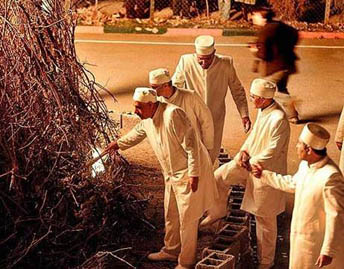 During ancient times, the fires were always set near water and the temples (see also: Fire temple). The fire originally meant to assist the revival of sun and bring back the warmth and light of summer. It was also meant to drive off the demons of frost and cold, which turned water to ice, and thus could kill the roots of plants. During ancient times, the fires were always set near water and the temples (see also: Fire temple). The fire originally meant to assist the revival of sun and bring back the warmth and light of summer. It was also meant to drive off the demons of frost and cold, which turned water to ice, and thus could kill the roots of plants.
The fire was kept burning all night. The day after, women would go to the fire in the morning, each taking a small portion of the fire back to their homes to make new glowing fire from the "blessed fire" of the temple. This is to spread the blessing of the Sadeh fire to every household in the neighborhood. Whatever is left from the fire would be taken back to the shrine to be placed in one container and kept at the temple until the next year. This way the fire is kept burning all year round. The "eternal fire" also symbolizes the love of homeland which is always alive like a fervent fire in the people's hearts.
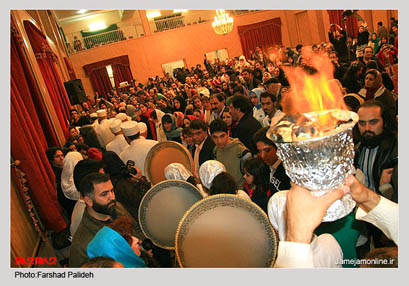 The festivities would normally go on for three days. The evenings are spent eating and giving out foods as donations, food that is prepared from slaughtered lambs and is distributed among the poor people. The festivities would normally go on for three days. The evenings are spent eating and giving out foods as donations, food that is prepared from slaughtered lambs and is distributed among the poor people.
The most elaborate report of the celebration of Sadeh after the dominations of Muslims over Iran comes from the 10th century AD during the reign of Mardavij of Ziyarid dynasty, the ruler of Isfahan. Ziyarid dynasty did their best to keep the Persian traditions alive. Bonfires were set up on both sides of the Zayandeh River to remember the Sadeh custom. The fires were kept in specially built metal holders. Hundreds of birds were released while the fireworks were lighting the sky. There were fireworks, dancing and music with lavish feasts of roasted lamb, beef, chicken and other delicacies.
Today the ceremony is celebrated somehow like the ancient times in some Iranian cities such as Kerman and Yazd. Jashn e Sadeh is also celebrated every year in the Kushke Varjavand gardens in Karaj (a township of Tehran province) splendidly with the presence of Iranian Zoroastrians and others interested in traditional Persian ceremonies. Sometimes the fires are not lit outside and all activities take place inside the Zorostrian temples. The activities of camel thorn gathering have almost been stopped though there are efforts to preserve the tradition. However, the bulk of the Iranians are becoming more familiar with the occasion and there are gatherings and celebrations even outside the country on 30 January each year. People will gather and pray, and then they will hold each other's hands, form a circle, and dance around the fire.
Every year, on 30 January, thousands of Zoroastrians in Iran and other countries celebrates the religious feast of Jashn-e Sadeh by burning firewood in an open space to signify the coming of spring and as a symbolic token of the eternal fight with mischief.
There is a cave in a mountain near Yazd, called Chak-Chak Fire Temple. Every year some special ceremonies are held in this place during the Sadeh Feast. It is believed that the last Zoroastrian princess took shelter there in 640 AD when the Muslims expanded their power to the east.
Although for the majority of Iranians Sadeh has no religious significance and no specific rituals are involved other than lighting fires at sunset and having a cheerful time, Iranians of all faiths make a collective effort at this day to keep up with their ancient traditions and to celebrate the precious things God granted humanity.
Sadeh has a complex history and two different days were observed for the festival's veneration. In addition to 50 days (100 days and nights) before the beginning of the new year (or hundredth day after the gahambar of Ayathrima), already noted, the other celebration marked the hundred day before the religious new year (religious new year is not necessarily the same as spring new year). It is not clear why there are two Sadeh Festivals and why different regions have had different dates. Many of Zoroastrian holy days were and are celebrated twice; this is most likely caused by the calendar reform in the 3rd century AD.
|